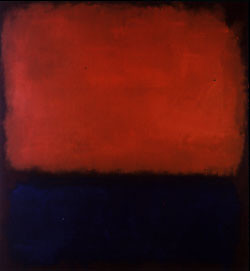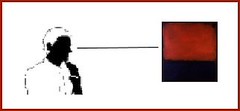Saturday, June 18, 2005
SF Museum of Modern Art
This afternoon I drove over to the San Francisco Museum of Modern Art. It's a favorite spot but I only get there two or three times a year, so I always see it with new eyes. The collection is far out enough to inspire fresh thoughts. After walking through a massive exhibit of black & white photographs from 1850 to the present day and watching a striking, three-screen video collage based on Sarah Winchester's attempts to exorcise the ghosts of the people killed by her family's firearms, I headed down to the permanent collection.
 I stopped to contemplate a massive Rothko. This is one of those Rothkos that looks like a window. A big window: it's about 9' by 9'. The top blob is a rich orange; it floats above a deep purple blob.
I stopped to contemplate a massive Rothko. This is one of those Rothkos that looks like a window. A big window: it's about 9' by 9'. The top blob is a rich orange; it floats above a deep purple blob.
I've been here before, but I'd never understood why. Something pulled me in, like the Richard Dreyfuss character in Encounters of the Third Kind who builds a mud model of Devil's Tower in his den and then just has to go there. I imagine I've clocked an hour in front of this particular Rothko of the course of six or seven visits. How can a couple of blobs, great blobs but blogs none the less, mesmerize a relatively savvy guy?
I realized I'd been looking in the wrong place. The magic wasn't the canvas and the paint. No, the power comes from the effect this Rothko has on me. It's the Rothko, my perceptions, and how I feel about the Rothko, all wrapped into an experience, that count.
 Hide the Rothko from view and its power disappears. I wander through life, thinking I'm a separate entity, able to stand alone, like I once thought the painting did. Then I awaken, realizing that I'm really no more than the sum of my connections. Hide me from connections to things outside of me and I disappear. Like my relationship with the painting, I'm defined by my bridges to things outside of me.
Hide the Rothko from view and its power disappears. I wander through life, thinking I'm a separate entity, able to stand alone, like I once thought the painting did. Then I awaken, realizing that I'm really no more than the sum of my connections. Hide me from connections to things outside of me and I disappear. Like my relationship with the painting, I'm defined by my bridges to things outside of me.
Titanic waves of information continually bombard our senses yet only a trickle makes it to our consciousness. Last night I read about a peculiar art work by Robert Rauschenberg in Ellen Langer's On Becoming an Artist. The story is that Rauschenberg asked Willem de Koonig for a drawing he might destroy. De Koonig, being somewhat old-school about art, very reluctantly agreed. Rauschenberg spent a month meticulously erasing the drawing. Then he framed and exhibited the canvas as Erased de Koonig Drawing, 1953, immediately making his mark at the beginning of a new tradition in art. That's not the punchline.
Walking through a room hung with Jasper Johns, Jim Dine, and Robert Rauschenberg, I spotted a faded painting I hadn't noticed before. It was...you guessed it...Rauschenberg's Erased de Koonig Drawing, 1953. It has been in the collection for three years. I've passed it a dozen times but never saw it. Lots of life is like that.
A one-room exhbit from 2x4 , a design firm in NY, featured a thin flat panel on which the pages of a book were being turned. Faster and faster. It was an intriguing work. Jamming two formats together. Later the same frisson returned when I saw Demuth's "Fountain," the urinal he submitted to a Paris show. Readymade. Ordinary things. I've go plenty of ordinary stuff. I've long considered myself an artist -- in the closet, but an artist.
 I stopped to contemplate a massive Rothko. This is one of those Rothkos that looks like a window. A big window: it's about 9' by 9'. The top blob is a rich orange; it floats above a deep purple blob.
I stopped to contemplate a massive Rothko. This is one of those Rothkos that looks like a window. A big window: it's about 9' by 9'. The top blob is a rich orange; it floats above a deep purple blob.I've been here before, but I'd never understood why. Something pulled me in, like the Richard Dreyfuss character in Encounters of the Third Kind who builds a mud model of Devil's Tower in his den and then just has to go there. I imagine I've clocked an hour in front of this particular Rothko of the course of six or seven visits. How can a couple of blobs, great blobs but blogs none the less, mesmerize a relatively savvy guy?
I realized I'd been looking in the wrong place. The magic wasn't the canvas and the paint. No, the power comes from the effect this Rothko has on me. It's the Rothko, my perceptions, and how I feel about the Rothko, all wrapped into an experience, that count.
 Hide the Rothko from view and its power disappears. I wander through life, thinking I'm a separate entity, able to stand alone, like I once thought the painting did. Then I awaken, realizing that I'm really no more than the sum of my connections. Hide me from connections to things outside of me and I disappear. Like my relationship with the painting, I'm defined by my bridges to things outside of me.
Hide the Rothko from view and its power disappears. I wander through life, thinking I'm a separate entity, able to stand alone, like I once thought the painting did. Then I awaken, realizing that I'm really no more than the sum of my connections. Hide me from connections to things outside of me and I disappear. Like my relationship with the painting, I'm defined by my bridges to things outside of me.Titanic waves of information continually bombard our senses yet only a trickle makes it to our consciousness. Last night I read about a peculiar art work by Robert Rauschenberg in Ellen Langer's On Becoming an Artist. The story is that Rauschenberg asked Willem de Koonig for a drawing he might destroy. De Koonig, being somewhat old-school about art, very reluctantly agreed. Rauschenberg spent a month meticulously erasing the drawing. Then he framed and exhibited the canvas as Erased de Koonig Drawing, 1953, immediately making his mark at the beginning of a new tradition in art. That's not the punchline.
Walking through a room hung with Jasper Johns, Jim Dine, and Robert Rauschenberg, I spotted a faded painting I hadn't noticed before. It was...you guessed it...Rauschenberg's Erased de Koonig Drawing, 1953. It has been in the collection for three years. I've passed it a dozen times but never saw it. Lots of life is like that.
A one-room exhbit from 2x4 , a design firm in NY, featured a thin flat panel on which the pages of a book were being turned. Faster and faster. It was an intriguing work. Jamming two formats together. Later the same frisson returned when I saw Demuth's "Fountain," the urinal he submitted to a Paris show. Readymade. Ordinary things. I've go plenty of ordinary stuff. I've long considered myself an artist -- in the closet, but an artist.
